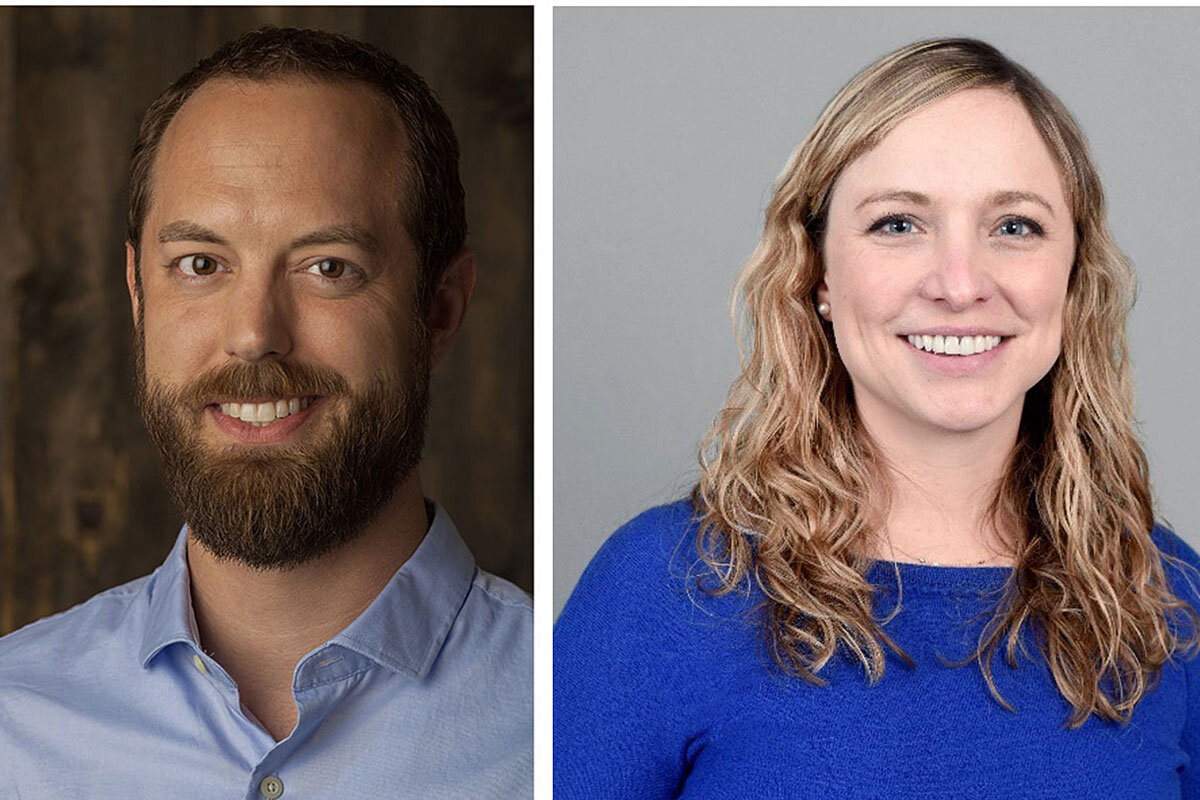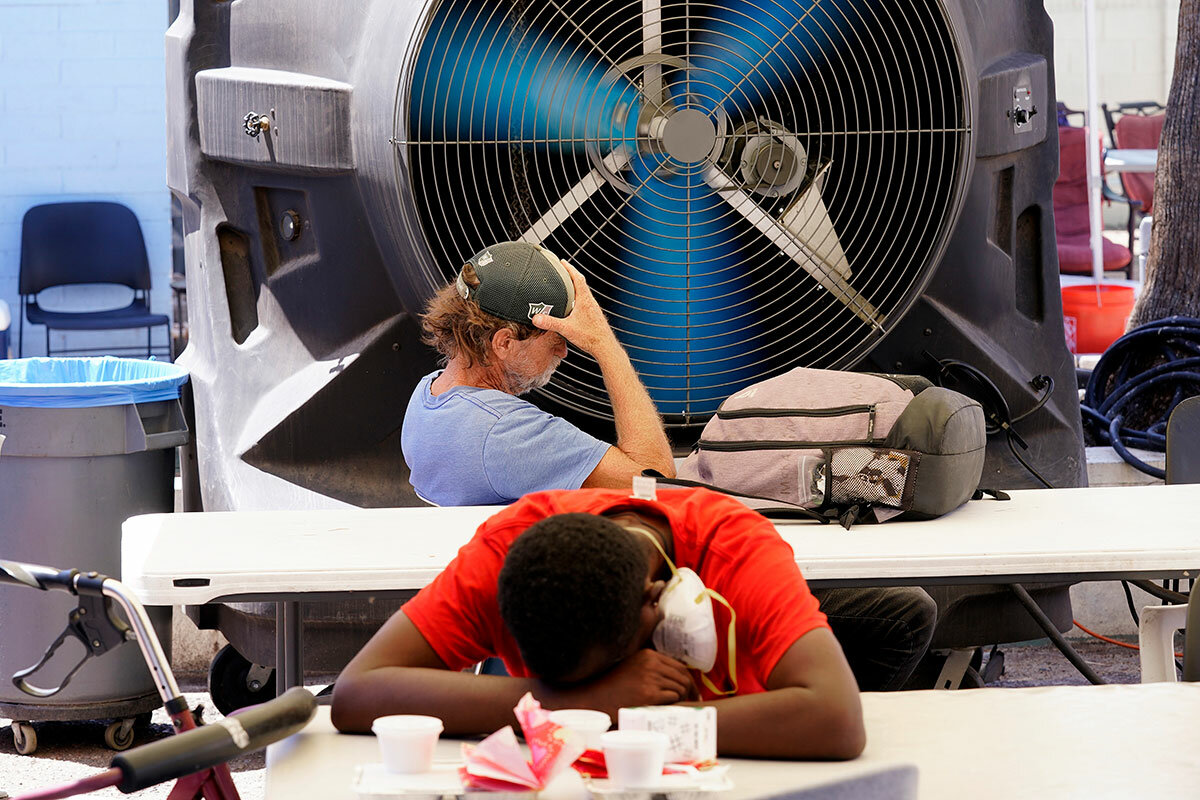How to cool cities, from heat officers to pavement sunscreen
Loading...
Heat waves in the headlines –��from Texas to Taiwan –��renew climate change calls to action. Beyond personal pledges, there’s interest in more systemic contributions from cities, which are disproportionate polluters of greenhouse gases.
From the sweltering state of Arizona, Ladd Keith and Sara Meerow outline possible solutions. Their American Planning Association published this year explores strategies for curbing urban – zones that are hotter than outlying areas – and urges paying more attention to heat equity.
“Everyone in the community should have a thermally safe indoor and outdoor environment,” explains Dr. Meerow, associate professor at the School of Geographical Sciences and Urban Planning at Arizona State University.��
Why We Wrote This
How can urban planning enhance heat resilience? Researchers say cooperation is key.
She and Dr. Keith, an assistant professor of planning at the University of Arizona, spoke with the Monitor about heat equity, projects to watch, and how cooperation is key to heat resilience. The conversation has been edited for length and clarity.��
Within the field of urban planning aimed at climate resilience, how new is this focus on heat?��
Dr. Keith: Heat’s received less attention, historically, than other hazards like wildfire, sea level rise, flooding, extreme storms, drought. It’s really only been in the last few years that communities have been taking heat risk seriously.
Is it purely the temperatures we’re clocking, or other societal factors that are pushing this new interest?
Dr. Meerow: There is a in increased intensity and duration of heat waves. There’s also been a number of these really unprecedented extreme heat events, like last summer in the of the U.S. and in British Columbia. This year, obviously, [Europe has] received a lot of attention because they are so out of the norm. I think that has helped also bring more attention to the issue.
Your report lays out two key components of urban heat resilience: heat mitigation and heat management. Could you spell out the differences with a few examples?��
Dr. Keith: Heat mitigation is the idea that you reduce the urban heat from that urban heat island. It’s strategies that reduce vehicle [exhaust] and air-conditioning waste to make buildings more efficient. ... Also looking at using materials that are more reflective and lighter in color so that they trap less heat to start off with, so that’s things like cool pavement or cool roofs or even cooler walls for the design of buildings. And of course urban greening is a popular strategy.��
Heat management is all about preparing and responding to both chronic heat – the general rise in average temperatures – but also those acute heat risks like those extreme heat events that we’ve been seeing with increasing frequency. That really involves the public health sector, the emergency managers doing things like opening more cooling centers, making sure that people have thermal equity in their homes and they have access to safe indoor environments.
Phoenix, long known for its high heat, last year announced the launch of the country’s first publicly funded office focused on urban heat hazards – the Office of Heat Response and Mitigation. What’s the significance of this?
Dr. Keith: An office or a position like this can really help coordinate some of those heat mitigation and heat management efforts that are historically siloed across different disciplines. Urban planning, emergency management, public health – they don’t necessarily all talk to each other. … Miami-Dade County and Los Angeles have both created chief heat officers as well.
Dr. Meerow: The key word there is coordination, and that’s really what this office is about. I think it’s also significant that this office specifically does acknowledge the need for both that mitigation and response – or management, as we term it.
I’d like to hear more about that, because one of your seven planning principles is “coordination across planning efforts.” Why is cooperation so important, and who should that involve?
Dr. Keith: The important thing is that we don’t give the wrong impression that you need a chief heat officer to address heat. That’s a really important message … especially for smaller towns and smaller communities that don’t necessarily have the resources for a full-time chief heat officer.��
I think that’s where that coordination becomes really important. … We’re forging new relationships and new processes and new partnerships.
Dr. Meerow: We want to make sure that they’re also not working past each other or at cross-purposes. So making sure that if we have efforts to try and cool a particular area of the city in one plan, … there’s not another [department] that is planning a new parking lot [there]. ��
That reminds me of the Maricopa Association of Governments’ , which coordinates things like hydration and cooling stations with various public and private partners. Are there other salient examples, from the Southwest or other regions, where cooperation has paid off in urban heat resilience efforts?��
Dr. Keith: We’re actually taking that cooperation … to the state level now [with]��a coordinated [in Arizona], and we’re taking those lessons [from different locations]��and applying them statewide.
New York City has a really well-respected [model] addressing heat efforts. They have their plan; they have a where people actually check on vulnerable neighbors and those that are recipients of social services during peak heat periods to make sure that they’re actually physically OK.��
Is it too early to have any data, any evidence yet on design or planning principles in urban areas that have worked well to reduce heat hazards for some of the most marginalized communities?��
Dr. Keith: There’s not a single silver bullet to solve heat inequities, unfortunately. But … there’s very good evidence that historically marginalized communities, lower-income communities, minority communities have higher heat severity than their whiter and richer counterparts across the country and across the world.
We know the ways that we can help address that, which is increasing urban greening, making sure that when we have any kind of public investments or public projects that we’re strategizing those resources and investing in the communities that need the help the most. … Also making sure that everyone has access to affordable housing and quality housing so that you can afford air conditioning.
There are some catch-22s for urban planning with heat resilience in mind. Planting trees, for instance, takes time for those trees to mature and relies on water that could be allocated elsewhere. What can help cities think through some of these trade-offs?
Dr. Meerow: If we know that trees take water and water is a precious resource, we still might prioritize planting trees in communities that we know have a much lower tree canopy cover than other ones, which tend to be lower-income, minority communities in many places.
Dr. Keith, you’re part of a team that’s evaluating Tucson’s . Can you elaborate on the project’s goal, and what exactly is this “asphalt rejuvenator” you’re studying?��
Dr. Keith: Many cities are looking at cool pavement pilot projects. Los Angeles and Phoenix have been looking at [a coating] that you literally put on the streets, and [it] reflects more light and retains less of the heat. Tucson’s looking at an asphalt rejuvenator, which acts as more of a sunscreen for the road.��
I’m wondering what, if anything, gives you hope?
Dr. Keith: I think we still have a long way to go, but we’re seeing good first steps in coordinating and addressing heat better.
Dr. Meerow: People have always died from heat, but I think people are just more aware of it, more concerned. I think that’s true of climate issues and climate change more broadly.
It sounds like awareness is a precursor to cooperation, and that cooperation is a precursor to innovation.��
Dr. Keith: One hundred percent. … Getting the stories out about what the risks are and how you can address heat is just so critical, so that communities that haven’t yet experienced that record-breaking heat wave – that they likely will in the future – can start preparing today.
Editor’s note: Dr. Keith’s description of the pavement projects in Los Angeles and Phoenix has been clarified.






